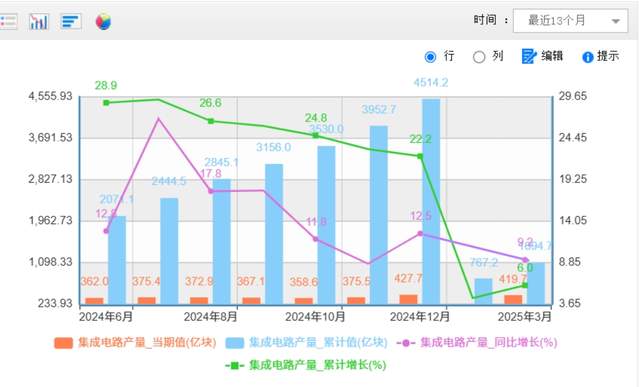Is China's Chip Production Poised to Slow Down in 2025?
![]() 05/12 2025
05/12 2025
![]() 613
613
China's chip industry has witnessed remarkable growth in recent years, evidenced by the soaring production figures. In particular, 2024 marked a significant milestone with a total chip production of 451.42 billion units, registering a year-on-year increase of 22.2%. Throughout that year, nearly every month recorded a double-digit growth rate, with some months even surpassing 35%.

However, the outlook at the dawn of 2025 is less sanguine, as the industry experiences a noticeable slowdown. Statistics from the National Bureau of Statistics reveal that for the first quarter of 2025, both the year-on-year and cumulative growth rates fell below 10%.
Specifically, domestic chip production amounted to 109.47 billion units in the first three months, marking a mere 6% increase from the previous year. The growth trajectory for this quarter is markedly lower than any month in 2024, as illustrated by the following chart (green and purple lines represent cumulative and monthly growth, respectively).

The question arises: why has the growth rate of domestic chip production declined so sharply in the first quarter of 2025 compared to the previous year? Part of the reason lies in the inclusion of the Spring Festival holiday, which naturally slows down production activities. Moreover, the chip industry is inherently cyclical. In 2024, the global chip industry was expanding, driving rapid growth in China. Conversely, as the global industry enters a downturn in 2025, domestic chip production is bound to be affected, leading to a lower growth rate compared to 2024.

To further contextualize this slowdown, consider another set of data: from January to March 2025, China imported 131.25 billion units of integrated circuits, with an 8.1% year-on-year increase, outpacing the growth rate of domestic chip production. This comparison underscores the challenging situation we face, reinforcing the need to enhance domestic production capacity and self-sufficiency rates amidst a volatile external environment.
Currently, the modest growth rate of domestic chip production, coupled with a higher import growth rate, suggests that progress towards self-sufficiency is not as swift as desired. Therefore, concerted efforts are imperative to address the ongoing chip shortage, as the journey towards self-reliance remains arduous and lengthy.







